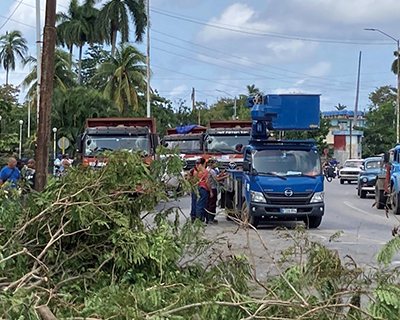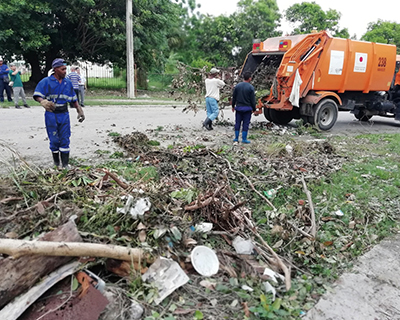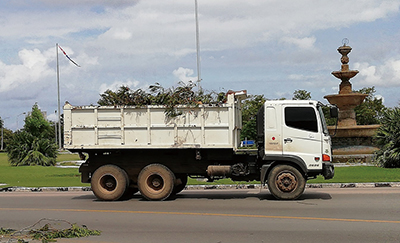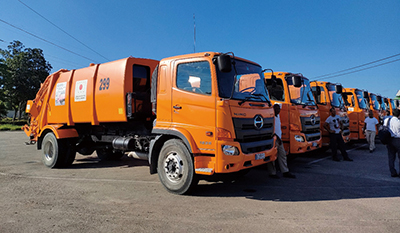Column
Japanese Cooperation on the Roads in Havana: Scenes in the Field Through the Eyes of the Evaluation Team
In the summer of 2022, restrictions on overseas travel were eased as the COVID-19 pandemic finally subsided. It was also possible to resume local visits and investigations as part of MOFA’s third-party ODA evaluations for the first time in three years. An evaluation team visited Havana, the capital of Cuba, from September 21 to October 1 to evaluate the “JFY2016 Grant Aid to Cuba (Economic and Social Development Programme)” through which 100 waste collection vehicles and other items were supplied to Havana, as well as the “JFY2017 Grant Aid to Cuba (Economic and Social Development Programme)” in the following year, through which urban space maintenance equipment such as dump trucks and aerial vehicles were supplied to the same city. (Refer to “Evaluation of “Japan’s Grant Aid for Economic and Social Development Programme to Cuba in JFY 2016” and “Evaluation of “Japan’s Grant Aid for Economic and Social Development Programme to Cuba in JFY 2017”.)
In Havana, the team visited the relevant ministries and agencies, as well as the city’s health and disaster prevention authorities. They also toured the repair shops for the vehicles supplied, waste collection facilities, and final disposal sites, among others. During the visits, they inspected how the equipment supplied by the Government of Japan is used and managed, and observed how it is actually contributing to waste disposal and disaster response measures in Havana. They spoke and listened to those working on-site and verified the environmental improvement effects of the assistance. At the same time, they identified new issues such as difficulties in obtaining replacement tires and batteries due to the shortage of foreign currency, as well as the final disposal site exceeding its capacity even though waste collection is being carried out smoothly.
During the evaluation team’s stay, from September 26 to 27, Hurricane Ian passed through Cuba and caused serious damage through torrential rain and strong winds. The whole country was hit by a power outage, and according to the Cuban government, the country suffered serious damage with three fatalities, approximately 7,000 evacuees, and 500,000 disaster victims. The evaluation team was trapped for a whole day and a half in their hotel in Havana. When the weather improved, they headed out into the city immediately and inspected the sites where city staff were engaged in recovery work using the chainsaws, aerial vehicles, dump trucks, and other equipment supplied by Japan.

Disaster restoration work after Hurricane Ian

Equipment supplied by Japan being used to remove disaster waste generated by Hurricane Ian
Cuba, located in the Caribbean, is constantly exposed to the threat of hurricanes. The seven major natural disasters that struck between 2016 and 2020 alone damaged more than 240,000 homes and caused economic losses of about $700 million. The shortage of equipment is not only directly linked to delays in disaster reconstruction, but also makes it difficult to carry out preventive logging for trees at risk of falling, which in turn leads to more widespread damage. While this hurricane landfall was an unfortunate event, the evaluation team was able to take the opportunity to verify the actual operation of the equipment supplied. This was one of the greatest yields of the field visit by the evaluation team.

Dump trucks supplied by Japan being used to remove disaster waste generated by Hurricane Ian
In the two years when it was not possible to travel to the local sites, the evaluation teams for each project used videoconferencing systems to interview the local stakeholders, and conducted inspections and interview surveys through local consultants. This confirmed that it is also possible to collect a certain amount of information through these substitute methods, and it expanded the options available in terms of the evaluation implementation methods. However, the saying that “seeing is believing” still holds true. It goes without saying that visiting the local sites in person, observing the field of ODA with one’s own eyes, and meeting partners personally to listen to their candid views, make it possible to obtain first-hand information.
When we visit the heart of Havana, we can see orange-colored waste collection vehicles affixed with the flag of Japan driving around the city. Such equipment supplied by Japan in conjunction with the 120th anniversary of Japanese migration to Cuba and the 90th anniversary of the establishment of diplomatic relations between Japan and Cuba, are a symbol of the long-standing friendship between the two countries and serve to publicize Japanese cooperation to the people of Havana.

Garbage Compactor Trucks supplied by Japan
